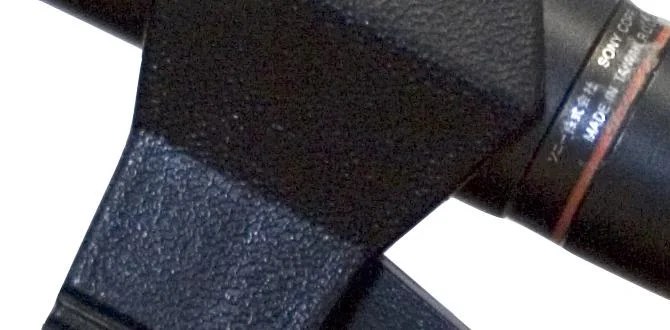Have you ever wondered how to get the best sound from a microphone on your Mac? Many people don’t realize that small changes can make a big difference. Imagine talking into your microphone and hearing clear, crisp audio. It’s not just a dream; it can be your reality with the right Mac microphone settings!
Whether you’re recording a podcast, chatting with friends, or joining a virtual class, sound quality matters. No one enjoys fuzzy audio or annoying background noise. A simple tweak in your settings can turn frustrating sound into something amazing. Did you know that most Macs have built-in tools to help you set up your microphone perfectly?
In this article, we will explore how to fine-tune your microphone for Mac settings. You’ll learn fun tips and tricks to enhance your audio experience. Ready to enjoy better sound? Let’s dive into the world of microphone settings together!
Microphone For Mac Settings: Optimize Your Audio Experience

Microphone for Mac Settings
Setting up your microphone for a Mac can be easy and fun. Did you know that some simple adjustments can make your voice sound clearer? Start by selecting your microphone in the system preferences. Next, check the input volume level. It’s important to find the right balance so others can hear you well. Also, explore apps that let you test your microphone settings. This way, you can sound your best during calls or recordings!
Understanding Microphone Types Compatible with Mac
Dynamic vs. Condenser Microphones. USB vs. XLR Connections.
Microphones come in two main types: dynamic and condenser. Dynamic microphones are like tough little warriors; they’re great for loud sounds but not as sensitive. Condenser microphones, on the other hand, are your soft-spoken friends, picking up every tiny whisper and sound. When it comes to connections, USB microphones are easy to use and plug right into your Mac. XLR microphones are for the pros; they need special mixers but offer high-quality audio. Choosing the right mic can feel like choosing your favorite ice cream flavor—fun but tricky!
| Type | Features |
|---|---|
| Dynamic | Rugged, handles loud sounds well |
| Condenser | Sensitive, captures delicate sounds |
| USB | Easy to set up, great for beginners |
| XLR | Professional quality, requires extra gear |
So remember, your choice depends on what you plan to do. Are you recording a rock band or speaking softly into a podcast? Choose wisely, and may your audio be clear!
Setting Up Your Microphone on Mac
Physical connection process. Installing necessary software or drivers.
First, plug your microphone into a USB port on your Mac. That’s like giving it a cozy home! Next, you might need some software or drivers to help it work. Check the manufacturer’s website for downloads. If your mic comes with a CD, don’t throw it like a Frisbee; it might hold important software! Once everything is installed, let’s make sure your Mac recognizes your microphone.
| Step | Action |
|---|---|
| 1 | Connect microphone to USB port. |
| 2 | Download necessary software, if needed. |
| 3 | Check Mac settings to ensure the mic is recognized. |
Don’t forget to check the volume settings. A mic with low volume is like a ninja—silent but not always effective! Now, you’re ready to chat, record, and become a podcast star!
Configuring Sound Preferences on Mac
Accessing System Preferences. Adjusting input volume levels.
To kick things off, you’ll want to dive into your System Preferences on your Mac. This is where the magic happens! Click the Apple icon at the top left, then select “System Preferences.” It’s like opening a treasure chest full of shiny settings! Next up, adjust your input volume levels. Make sure your microphone isn’t too quiet or loud. A happy medium keeps your voice clear without making it sound like a robot! Let’s not scare the cats in the house, right?
| Step | Action |
|---|---|
| 1 | Click the Apple icon |
| 2 | Select “System Preferences” |
| 3 | Adjust input volume |
Utilizing Audio Settings for Better Performance
Enabling the correct audio input source. Reducing background noise with settings.
To make your microphone work like a superstar, first, choose the right audio input source! It’s like giving your mic a cozy home. Select “System Preferences,” click on “Sound,” and choose the microphone you want, like selecting the best ice cream flavor. Yum! Next, tackle background noise. You can reduce it with special settings that cut out distractions. Think of it as putting on noise-canceling headphones for your mic! Now, let’s see some handy settings:
| Setting | Description |
|---|---|
| Select Input Source | Choose your microphone from the list. |
| Noise Reduction | Enable this to minimize background sounds. |
| Input Volume | Adjust it to make your voice clear and strong. |
With these small changes, your audio quality can improve by a huge margin. Your friends will hear you loud and clear, and they won’t even guess if you’re hiding in a pillow fort!
Troubleshooting Common Microphone Issues on Mac
No audio input detected. Distorted sound quality.
Microphone problems on a Mac can be tricky, but we can tackle them together! If your Mac says, “I don’t hear anything!” it probably means there’s no audio input detected. First, check if your microphone is actually plugged in. If it is, you might need to tweak some settings. If your voice sounds like a robot, it could be a sign of distorted sound quality. Try adjusting the input volume or repositioning the microphone. Here’s a quick table to help you:
| Issue | Solution |
|---|---|
| No audio input detected | Check the connection and settings. |
| Distorted sound quality | Adjust the input volume and reposition. |
Follow these steps, and soon you’ll be sounding clearer than a podcast host! 🎤
Best Microphone Settings for Different Applications
Settings for Voice Recording Software. Optimizing settings for Video Conferencing.
Choosing the best microphone settings can make all the difference in your projects. For voice recording software, set the gain to avoid distortion. Too much gain, and you’ll sound like a robot caught in a blender. For video conferencing, keep the noise reduction on. You want to hear your friend’s funny jokes, not their dog barking in the background! Check out the table below for quick settings:
| Application | Best Microphone Setting |
|---|---|
| Voice Recording | Gain: Low-Medium, Noise Filter: Off |
| Video Conferencing | Gain: Medium, Noise Filter: On |
These tweaks ensure you sound clear and professional, whether you’re recording your new podcast or catching up with friends online. Happy chatting!
Advanced Audio Configuration Options
Using thirdparty audio software. Implementing EQ and sound enhancement tools.
When it comes to making your voice sound as smooth as butter, third-party audio software is your best friend. These tools can be like a magic wand for your microphone settings. You can add effects that make your voice sound richer or even a little funnier. Ever wanted to sound like a deep-sea diver or a robot? Now you can! Here’s a quick look at some useful audio settings that can help you enhance your sound:
| Tool | Function |
|---|---|
| EQ (Equalizer) | Adjusts different sound frequencies for clarity. |
| Compression | Evens out volume levels, so you don’t sound too quiet or loud. |
| Reverb | Adds space and depth to your voice. |
Using these features can make your audio clearer and more professional. Who doesn’t want to sound like a star on a podcast? So, take a dive into the settings and start playing around! 🎤✨
Maintaining Your Microphone and Setup
Regular cleaning and upkeep. Ensuring software updates for compatibility.
Keeping your microphone in top shape is like taking care of a pet. It needs regular cleaning! Wipe off dust and crumbs to ensure clear sound. You wouldn’t want your voice to sound like it’s coming from a cave, right? Also, software updates are crucial. They help your microphone stay compatible with your Mac. Think of it as getting a new wardrobe for your microphone—everyone loves a fresh look! Here’s a quick table for easy maintenance:
| Task | Frequency |
|---|---|
| Clean Microphone | Every week |
| Check for Software Updates | Monthly |
Conclusion
In conclusion, adjusting your microphone settings on a Mac is essential for clear audio. You can manage volume levels, input sources, and effects easily. Remember to test your mic before important calls or recordings. For more detailed guidance, check Apple’s support site or the settings menu. With a little practice, you’ll sound great every time!
FAQs
How Do I Adjust The Microphone Input Volume On My Mac?
To change the microphone volume on your Mac, first, click on the Apple logo in the top-left corner. Then, choose “System Preferences.” Next, click on “Sound.” In the Sound menu, go to the “Input” tab. Here, you can move the slider to make your microphone louder or softer.
What Settings Should I Configure For External Microphones Connected To My Mac?
To set up an external microphone on your Mac, first, plug it in. Then, click on the Apple logo in the corner. Go to “System Preferences” and choose “Sound.” In the “Input” tab, find your microphone and select it. Make sure the input volume is loud enough so it picks up your voice. You’re all set!
How Can I Troubleshoot Microphone Issues On My Mac If It’S Not Picking Up Sound?
To fix microphone problems on your Mac, first check the connections. Make sure your microphone is plugged in tightly. Next, go to “System Preferences” and click on “Sound.” Under the “Input” tab, choose your microphone. You can also test it by speaking and watching the input level move. If it still doesn’t work, try restarting your Mac.
Where Can I Find And Modify The Microphone Settings In Macos System Preferences?
You can find microphone settings in your Mac’s System Preferences. First, click on the Apple logo in the top left corner. Next, choose “System Preferences.” Then, click on “Sound.” In the Sound menu, you’ll see a “Input” tab. Here, you can adjust the microphone settings.
How Do I Switch Between Different Microphone Sources On My Mac For Applications Like Zoom Or Skype?
To switch microphones on your Mac for Zoom or Skype, first, open the app. Then, look for “Settings” or “Preferences.” Click on it, and find the “Audio” section. Here, you can choose which microphone to use from the list. Finally, select the one you want, and you’re ready to go!






